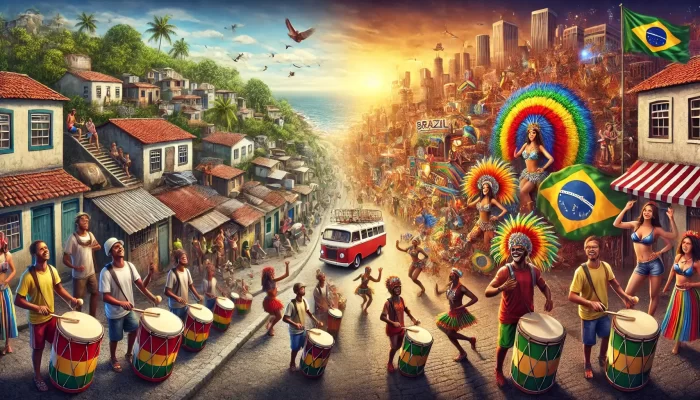Samba is more than just a genre of music — it’s a cultural symbol, a dance, a celebration, and a deeply rooted part of Brazil’s national identity. Its rhythm pulses through Carnival parades, street corners, and global stages. But how did samba come to be? Let’s explore the fascinating origin of samba, how it evolved, and why it continues to captivate the world.
The African Roots of Samba
Samba has its earliest roots in the rhythms and traditions brought to Brazil by enslaved Africans, particularly from Angola and the Congo. These African communities carried with them not just instruments and melodies, but a rich heritage of music and movement centered around drums and call-and-response singing.
In particular, the “samba de roda”, a communal dance and musical style from the northeastern state of Bahia, is considered one of the earliest forms of samba. It combined African drumming, chanting, and dance with Portuguese instruments and melodies, creating a unique cultural fusion.
From Bahia to Rio: The Urbanization of Samba
In the late 19th and early 20th centuries, large numbers of Afro-Brazilians migrated from Bahia to Rio de Janeiro, seeking work and a new life in the bustling capital. They brought their musical traditions with them.
In Rio, samba evolved in the working-class neighborhoods known as favelas, especially in areas like Cidade Nova and Praça Onze. It was here that samba began to take on a more urban character, influenced by European harmonies, Brazilian folk music, and the daily struggles of life in the city.
One of the earliest recorded sambas is “Pelo Telefone”, released in 1917 and attributed to Donga, a musician from one of Rio’s musical communities. This song is widely considered the first official samba recording and marked the beginning of samba’s rise as a national music genre.
Samba and the Rise of National Identity
In the 1930s and 40s, samba was embraced by Brazil’s government as part of a larger project to construct a unified national identity. Under the leadership of President Getúlio Vargas, samba was promoted as a symbol of Brazilian culture and unity — even though it had its origins in marginalized Afro-Brazilian communities.
This period saw the emergence of samba-canção, a slower and more melodic version of samba that became popular in radios and dance halls. Legendary artists like Noel Rosa, Ary Barroso, and Carmen Miranda helped samba reach middle-class audiences and gain national and international recognition.
The Birth of Samba Schools and Carnival Culture
No discussion of samba is complete without mentioning Carnival. Samba and Carnival are inseparable, and much of the genre’s evolution is tied to the elaborate parades and competitions held each year in Rio.
In the 1920s and 30s, organized groups known as “escolas de samba” (samba schools) began forming. These were not educational institutions, but rather community organizations that created massive floats, costumes, and music to perform during Carnival.
Each samba school prepares an “enredo” — a theme for their performance — and composes an original samba-enredo (theme samba song) each year. The competition between samba schools is fierce and deeply rooted in community pride, artistry, and tradition.
The Instruments That Define Samba
Samba’s infectious rhythm comes from its unique set of percussion instruments, each with its own role:
- Surdo: The deep bass drum that provides the heartbeat of the rhythm
- Tamborim: A small, high-pitched drum that cuts through the ensemble
- Cuíca: A friction drum with a unique squeaky sound, often associated with samba
- Pandeiro: A Brazilian tambourine used for intricate rhythms
- Agogô: A double bell that adds melodic percussion
- Reco-reco: A scraper that adds texture to the rhythm
Together, these instruments create the unmistakable groove of samba.
Different Styles of Samba
As samba evolved, it gave birth to many subgenres and styles, including:Samba de Gafieira: A ballroom-style samba danced in pairs Pagode: A more relaxed, informal version of samba popularized in the 1980s
Samba-rock: A fusion of samba with rock and soul elements
Samba-enredo: The music performed by samba schools during Carnival
Samba-canção: Slower, more romantic samba with poetic lyrics
Each style reflects a different aspect of Brazilian life and continues to evolve with new generations of artists.
Global Impact of Samba
Thanks to artists like Carmen Miranda, João Gilberto, and Sergio Mendes, samba found international audiences in the mid-20th century. Though bossa nova (a softer, jazz-influenced version of samba) became more globally popular, traditional samba still found its way into jazz, pop, and world music scenes.
Today, samba is recognized by UNESCO as an Intangible Cultural Heritage of Humanity, a testament to its global significance and rich history.
Why Samba Still Thrives
Samba is alive, vibrant, and constantly evolving. It thrives not just during Carnival but in bars, festivals, football matches, and everyday gatherings throughout Brazil. It’s a source of joy, resistance, and pride — especially for Afro-Brazilian communities who have preserved and enriched it for generations.
In an increasingly globalized world, samba remains a deeply local expression of Brazilian identity, while continuing to inspire artists and dancers around the globe.

